City of Luxembourg: its Old Quarters and Fortifications: In 963 AD, Count Siegfried built a castle on the Bock Rock. This castle was the birth of Luxembourg. The city of Luxembourg is located on a strategic position. The Bourbons, the Habsburgs, the French, the Spanish and the Prussians all wanted Luxembourg. The city of Luxembourg was enlarged and strengthened over the years by its successive occupants. The city of Luxembourg was from the 16th century until 1867 one of the greatest fortified sites in Europe. The Bock fortifications and Pétrusse casemates were built during the Spanish period in 1644. The casemates were enlarged and improved under the rule of France by the military engineer Vauban and under the rule of Austria in the 1730s and 1740s. Most of the fortifications were dismantled in 1867, the remaining fortifications still provide a good example of the military architecture from the past. The Grand Duchy of Luxembourg was created in 1815 by the Congress of Vienna and given to the King of the United Kingdom of the Netherlands. The Grand Duchy of Luxembourg was ruled by Dutch monarchs from 1815-1890. The King of the Netherlands remained Grand Duke of Luxembourg until his death in 1890. The Dutch throne passed to his daughter and only child Wilhelmina of Orange-Nassau, the Grand Duchy of Luxembourg passed to a male heir of the Nassau Family. The City of Luxembourg: its Old Quarters and Fortifications was declared a UNESCO World Heritage in 1994.
www.werelderfgoedfotos.nl © Copyright World Heritage Photos
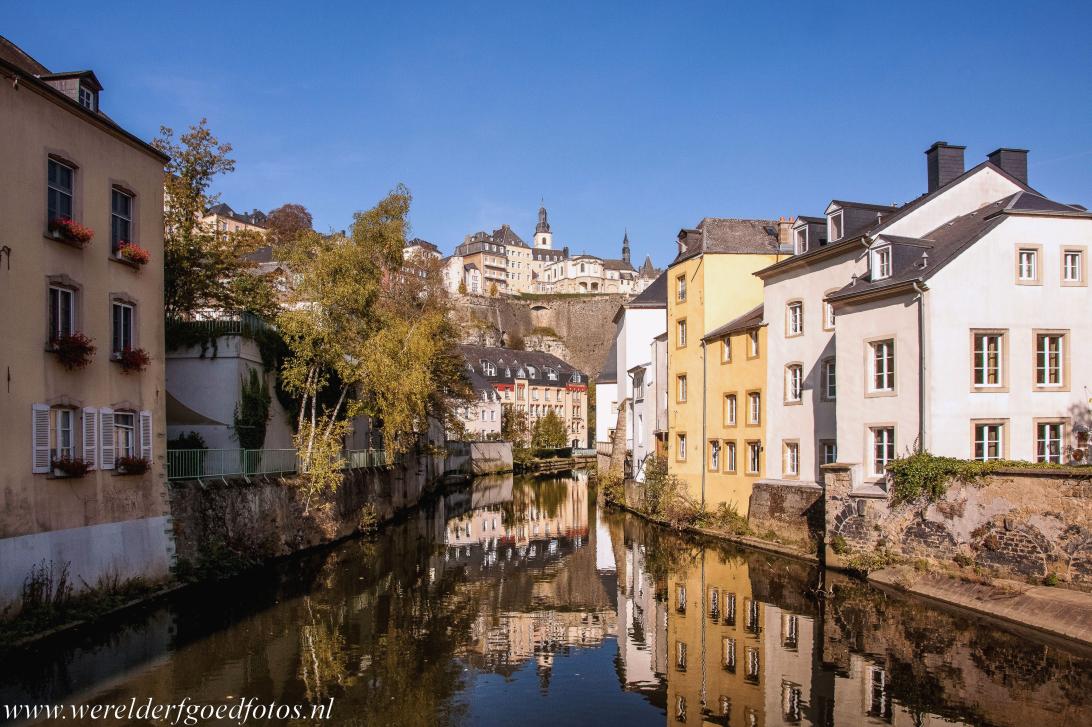
City of Luxembourg: its Old Quarters and Fortifications: View from the 'Grund' to the Old Town of the City of Luxembourg. Luxembourg is the capital city of the Grand Duchy of Luxembourg. In 963 AD, Count Siegfried built a castle on the Bock Rock, this castle was the birth of Luxembourg. The city of Luxembourg is situated on a strategic position, from the 16th century until 1867, the city was one of the greatest fortified sites in Europe.

City of Luxembourg: its Old Quarters and Fortifications: View from the 'Grund' to the Old Town of the City of Luxembourg. Luxembourg is the capital city of the Grand Duchy of Luxembourg. In 963 AD, Count Siegfried built a castle on the Bock Rock, this castle was the birth of Luxembourg. The city of Luxembourg is situated on a strategic position, from the 16th century until 1867, the city was one of the greatest fortified sites in Europe.
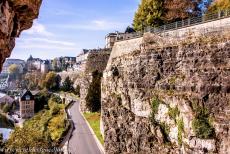
City of Luxembourg: its Old Quarters and Fortifications: The Bock fortifications offers a beautiful view of the Wenzel Wall and the Jacob's Tower, the Dinselpuert. In 963, Count Siegfried built his Lucilinburhuc Castle on the Bock Rock, this little fortress was the birth of the Luxembourg. The remains of the Lucilinburhuc Castle were discovered in the Bock fortifications in 1993. The Bock fortifications are open to the public.
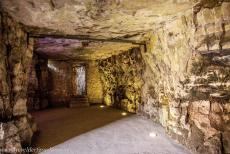
City of Luxembourg: its Old Quarters and Fortifications: Inside the Bock fortifications. The first fortifications were built during the Spanish period in 1644. Extensions were carried out by the French military engineer Sébastien Le Prestre de Vauban in 1684. A huge underground tunnel system of 23 km was built by the Austrians in the 18th century. It allowed to move soldiers and supplies without any risk from enemy fire.

City of Luxembourg: Old Quarters and Fortifications: A cannon inside the Bock casemates. The fortifications of the city of Luxembourg represent an overview of military architecture of several centuries. The greatest engineers came from all over Europe, among them the military engineer Vauban, leaving their mark on the fortifications of the city of Luxembourg. The Bock casemates also served as an underground shelter fot the residents of the city of Luxembourg during WWII.
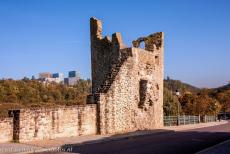
City of Luxembourg: its Old Quarters and Fortifications: The so-called Dent Creuse, the Hollow Tooth, is the remaining part of a fortified gatehouse of a medieval castle on the Bock Rock. The central location of Luxembourg made both the city and country of great strategic importance to many countries, the Bourbons, the Habsburgs, the French, the Spanish and Prussians all wanted Luxembourg. They made Luxembourg one of the strongest fortresses in Europe.
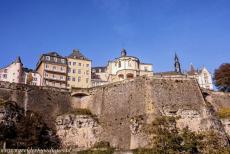
City of Luxembourg: its Old Quarters and Fortifications: The upper part of Luxembourg City and the Bock fortifications. The self guided Wenzel Circular Walk is a good way to explore the city of Luxembourg in about two hours, it leads along the historic sights. The Wenzel Circular Walk is named after Wenceslas II, Duke of Luxembourg from 1383 to 1419. During his reign, the Wenzel wall was erected, the third ring wall of the city.
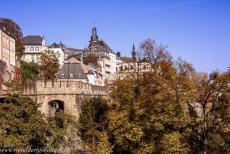
City of Luxembourg: its Old Quarters and Fortifications: The Ville Haute is the upper part of the city of Luxembourg, the Grund Gate in the foreground, the gate was built by the Spaniards in 1632. The upper part of the city is situated on the Block Rock, a steep rocky cliff high above the Alzette River. The rock offers a natural fortification, it is surrounded on three sides by the Alzette River. The Bock Rock was already inhabited by the Romans and the Franks.
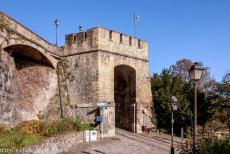
City of Luxembourg: its Old Quarters and Fortifications: The Grund Gate, the Ground Gate, is a 17th century city gate. The city of Luxembourg was enlarged and strengthened over the years by its successive occupants, such as the Bourbons, the Habsburgs, the French, the Spanish and Prussians. The city of Luxembourg: its Old Quarters and Fortifications, gained the status as a UNESCO World Heritage in 1994.
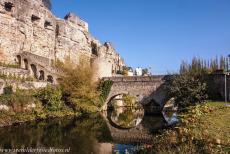
City of Luxembourg: its Old Quarters and Fortifications: The Stierchen Bridge was built in the 14th century, it is a stone footbridge across the Alzette River. The Stierchen Bridge is part of the Wenceslas Wall. The wall was built between 1383 and 1419, it was named after Wenceslas II, the Duke of Luxembourg. The Wenceslas Wall protected the lower part of Luxembourg, the wall had once 37 towers and 15 gates.
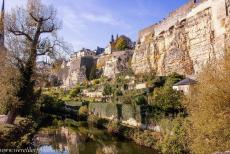
City of Luxembourg: its Old Quarters and Fortifications: Some of the oldest houses of the city of Luxembourg are situated in the Grund, the Ground. The Grund is the lower part of the city, the Ville Basse. The Neumünster Abbey is also situated in the Grund. The city of Luxembourg was regarded as the Gibraltar of the North because of all the fortifications. Most of the fortifications were dismantled in 1867.
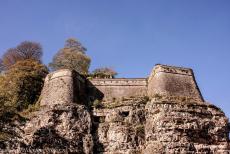
City of Luxembourg: its Old Quarters and Fortifications: The Pétrusse casemates, situated along the Pétrusse Valley. The Bock fortifications and the Pétrusse fortifications were built during the French and Spanish period in 1644. The fortifications were greatly expanded during the French period by Sébastien Le Prestre de Vauban, the chief military engineer of King Louis XIV. Between 1684 and1688, many fortifications were built around the city of Luxembourg.
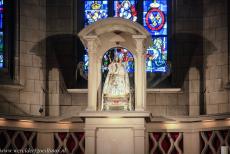
City of Luxembourg: its Old Quarters and Fortifications: The Notre-Dame Cathedral houses the 17th century statue of Mary the Consolatrix Afflictorum, the Comforter of the Afflicted, a patron saint Luxembourg. The Notre-Dame Cathedral was consecrated as the Church of Our Lady, the church was elevated to the Notre-Dame Cathedral in 1870, it is the only cathedral in the Grand Duchy of Luxembourg.
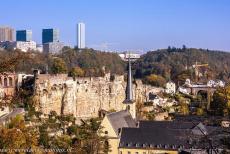
City of Luxembourg: its Old Quarters and Fortifications: The Rham Plateau in the upper part of the city of Luxembourg and the Bock casemates viewed from the Grund, the Grund is the lower part of the city of Luxembourg and one of the oldest parts of the city, it is situated on the banks of the Alzette River. The upper part of the city is called Ville Haute. In the foreground the spire and roof of the Neumünster Abbey, a 17th century former Benedictine monastery.
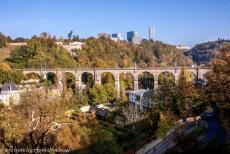
City of Luxembourg: its Old Quarters and Fortifications: The Pont Adolphe, the Adolphe Bridge, was named after the Grand Duke Adolphe, who reigned Luxembourg from 1890 until 1905. The Adolphe Bridge was inaugurated in 1903. The Adolphe Bridge was once the largest stone bridge in the world. The Pont Adolphe lies across the river Pétrusse, connecting the Ville Haute to the Gare quarter nearby the railway station. The bridge is a national symbol of Luxembourg.
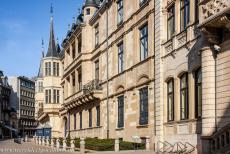
City of Luxembourg: its Old Quarters and Fortifications: The Grand-Ducal Palace of Luxembourg was built between 1572 and 1574. The Grand Duchy of Luxembourg was created in 1815 by the Congress of Vienna and given to the King of the United Kingdom of the Netherlands, the Grand Duchy of Luxembourg remained in Dutch hands until the death of King William III in 1890, the throne of the Netherlands passed to his only child, his daughter Princess Wilhelmina, the Grand Duchy passed to a male heir of another branch of the Nassau Family.
